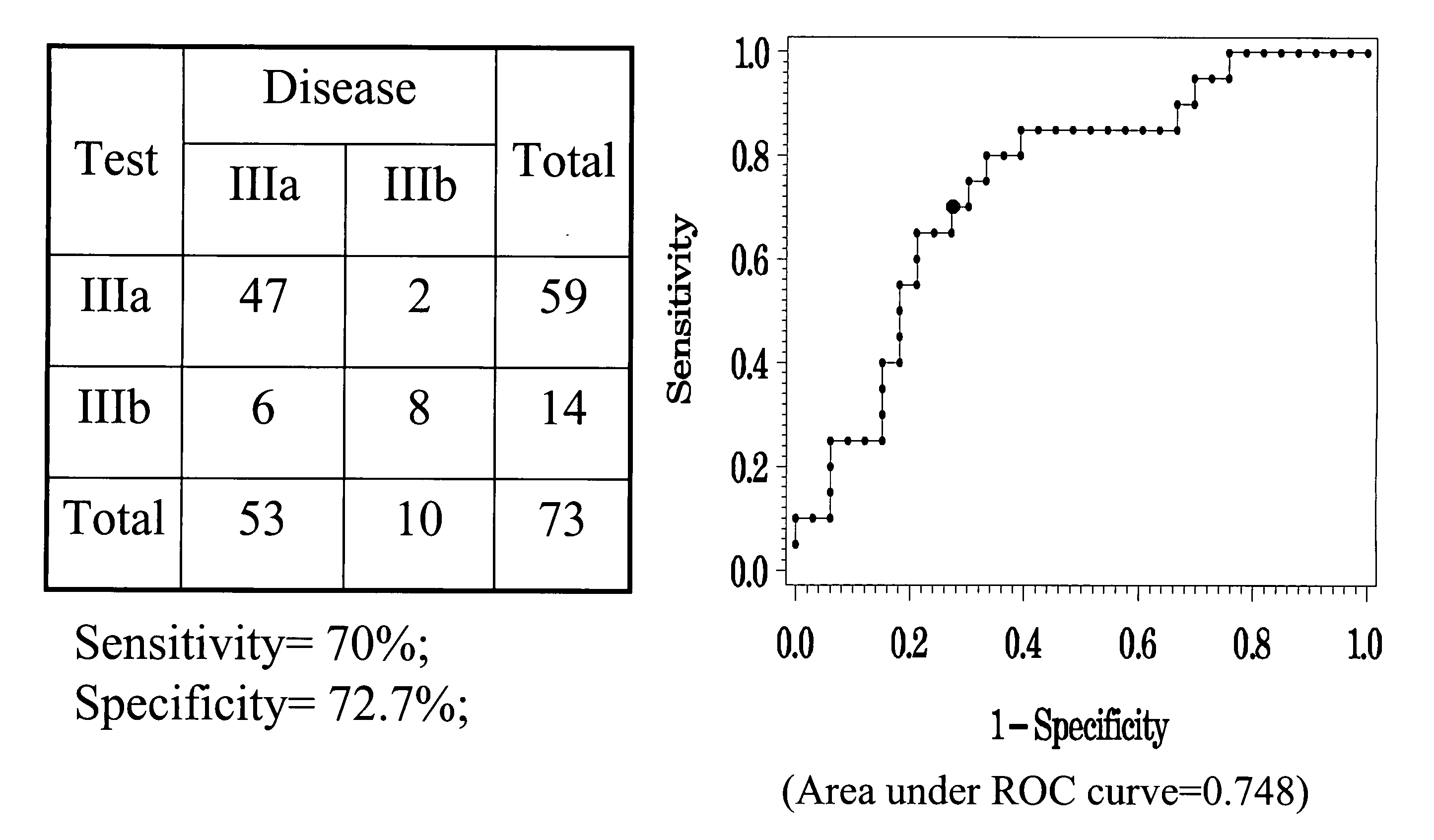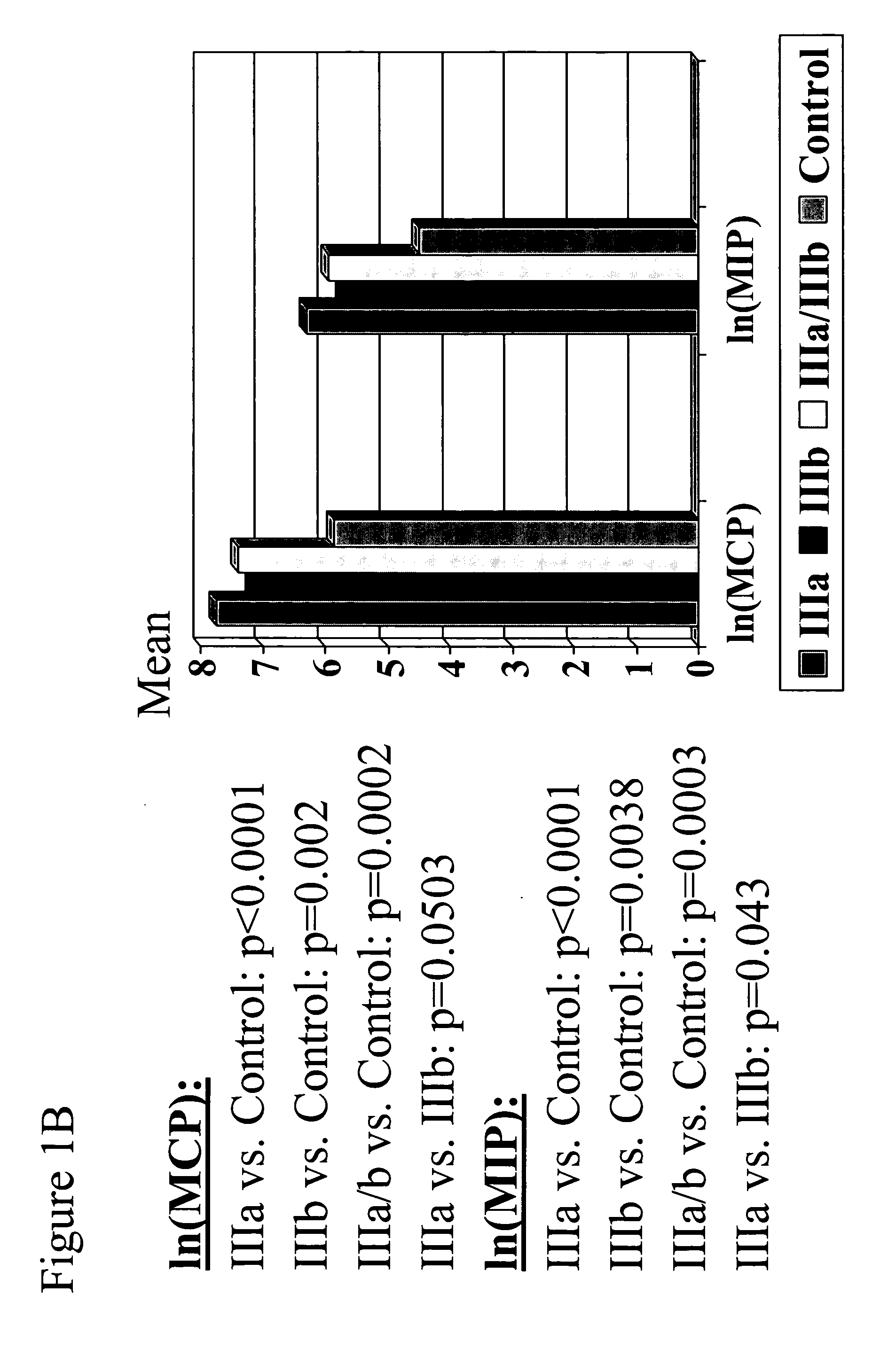Biomarkers of chronic pelvic pain syndrome
a biomarker and pelvis technology, applied in the field of chronic pelvis pain syndrome biomarkers, can solve the problems of burdensome patient treatment with multiple antibiotic courses, no evidence of patient benefit, and almost nothing about diagnostic criteria, etiology, etc., and achieve the effect of reducing the amount of labeled bounds
- Summary
- Abstract
- Description
- Claims
- Application Information
AI Technical Summary
Benefits of technology
Problems solved by technology
Method used
Image
Examples
example 1
Materials and Methods
Patients and Controls
[0249] Classification of patients is based on history (IIIa, IIIb, control), symptoms (according to National Institutes of Health-Chronic Prostatitis Index—NIH-CPSI), and expressed prostatic secretions of white blood cells per high power field (EPS wbc / hpf). Evaluation includes a complete history and physical examination, and includes a four-glass urine test as per published protocols (See, e.g., Nadler et al., Journal of Urology, 164:214-218 (2000), herein incorporated by reference in its entirety for all purposes).
[0250] Breifly, expressed prostatic secretion (EPS) samples were collected by digital rectal examination (DRE) from men seen in ambulatory clinic who had no urologic disease (controls, n=16), BPH (n=14); CPPS IIIA (greater than or equal to 10 white blood cells per high power field (WBC / hpf) in EPS) (n=18); CPPS IIIB (less than 10 WBC / hpf in EPS) (n=20); or AIP (n=10) (See table). Classification was based on history, symptoms,...
example 2
Identification of MCP and MIP as Markers for CPPS
[0256] Experiments conducted using the compositions and methods of the present invention indicate that MCP-1 and MIP-1α are significantly elevated in the EPS of patients with both type IIIa and IIIb CPPS compared to controls (See, e.g., FIGS. 1A and 1B). FIG. 1 shows the distribution of the values of MCP and MIP for three groups: Men with chronic prostatitis / chronic pelvic pain syndrome, 1) with inflammation (IIIA), 2) without inflammation (IIIB), and healthy men (the control group). The mean values are significantly higher for the two prostatitis groups as compared to the controls (See, e.g., FIG. 1A, comparing columns for IIIa, IIIb and IIIa / IIIb to control column. The same information composited on a log scale (LN) is also depicted (See, e.g., FIG. 1B). Thus, in some embodiments, the present invention provides markers for CPPS comprising MIP-1α and MCP-1.
example 3
Classification of CPPS Subjects Using MCP and MIP
[0257] The information generated in Example 2, FIG. 1 was then used to derive what are called “cut points,” which are the points that discriminate between cases and controls and give the sensitivity and specificity of these areas (See, e.g., FIGS. 2 and 3). The area under the curve refers to the confidence. The higher that the number approaches one, the more relevant the diagnostic value. For example, in FIG. 2, the area under the curve for the cutpoints described is 0.892, which is excellent. This means that an individual who has a value of MCP-1 of 1061 pg / ml or greater and MIP1a of 70 pg / ml or greater has an 89% chance of having chronic pelvic pain syndrome and there is an 80% chance that he does not have something else. Furthermore, these levels of cytokine expression are biologically significant, that is, they are in the same range of values that are seen in the fluid of, for example, patients with rheumatoid arthritis which is ...
PUM
 Login to View More
Login to View More Abstract
Description
Claims
Application Information
 Login to View More
Login to View More - R&D
- Intellectual Property
- Life Sciences
- Materials
- Tech Scout
- Unparalleled Data Quality
- Higher Quality Content
- 60% Fewer Hallucinations
Browse by: Latest US Patents, China's latest patents, Technical Efficacy Thesaurus, Application Domain, Technology Topic, Popular Technical Reports.
© 2025 PatSnap. All rights reserved.Legal|Privacy policy|Modern Slavery Act Transparency Statement|Sitemap|About US| Contact US: help@patsnap.com



